Assessment of Polycyclic Aromatic Hydrocarbons Contamination in Water, Sediment and Fish of Temsah Lake, Suez Canal, Egypt
H.R. Ali 1 , Nour 1 * , SH. El-Gendy 1 , S. El- Ezbewy 2 , G. H. El-Gemaee 2 , Y. M. Moustafa1 and M.I. Roushdy1 *
DOI: http://dx.doi.org/10.12944/CWE.1.1.03
The nature, origin and distribution of the listed reference US Environmental Protection Agency (EPA) priority pollutants; 16 polycyclic aromatic hydrocarbons (PAHs) were investigated in water, sediment and fish of Temsah Lake (Suez Canal, Egypt) using high performance liquid chromatography (HPLC). The compositions of PAHs determined in all samples were measured in order to use them as chemical markers for identifying different sources of PAHs pollution in the studied region. Qualitative and quantitative distribution of PAHs detected in all investigated samples have followed no particular pattern, but rather irregular. Quantitative determination of PAHs show that their concentration ranged from 52.46–3393µg/L, 585.9-8592.8µg/L and 1696.4–4785.7µg/L for water, sediment and fish samples, respectively. Data show that these values are considered to be alarmingly high and the studied areas have values high enough to cause lethal toxicity effect to the surrounding environment and consequently to the human health. All samples are characterized by low concentration of low molecular weight PAHs compared to high molecular weight PAHs. Sediment and fish samples are characterized by relatively high concentration of six membered rings PAHs. The origin of PAHs in collected samples is either petrogenic, biogenic or mixed petrogenic and biogenic.
Copy the following to cite this article:
Ali H.R, El-Gendy S, El-Ezbewy S, El-Gemaee G.H, Moustafa Y.M, Roushdy M.L. Assessment of Polycyclic Aromatic Hydrocarbons Contamination in Water, Sediment and Fish of Temsah Lake, Suez Canal, Egypt. Curr World Environ 2006;1(1):11-22 DOI:http://dx.doi.org/10.12944/CWE.1.1.03
Copy the following to cite this URL:
Ali H.R, El-Gendy S, El-Ezbewy S, El-Gemaee G.H, Moustafa Y.M, Roushdy M.L. Assessment of Polycyclic Aromatic Hydrocarbons Contamination in Water, Sediment and Fish of Temsah Lake, Suez Canal, Egypt. Curr World Environ 2006;1(1):11-22. Available from: http://www.cwejournal.org?p=10/
Download article (pdf)
Citation Manager
Publish History
Select type of program for download
| Endnote EndNote format (Mac & Win) | |
| Reference Manager Ris format (Win only) | |
| Procite Ris format (Win only) | |
| Medlars Format | |
| RefWorks Format RefWorks format (Mac & Win) | |
| BibTex Format BibTex format (Mac & Win) |
Article Publishing History
| Received: | 2006-05-08 |
|---|---|
| Accepted: | 2006-07-05 |
Introduction
Polycyclic aromatic hydrocarbons (PAHs) are classified as environmentally hazardous organic compounds due to their known hydrophobic and mutagenic characteristics in addition to its toxicity and carcinogenicity (Hatch and Burton, 1999). PAHs are included in the European Community (EC) and US Environmental Protection Agency (EPA) priority pollutant list (Anayakora et al., 2005). They are ubiquitous in the environment largely due to the extensive use of fossil fuels. Investigation of polycyclic aromatic hydrocarbons (PAHs) in the water bodies is a very important part of environmental quality assessment which determines the status of contamination and the impacts it may cause to the ecosystem. Despite the limited water solubility of PAHs, it has been shown that contact of water with PAH-contaminated sediment can lead to tetragenicity and toxicity of the water. Contaminated sediment in surface waters also represents a continuing source of contamination in the aquatic food chain. The toxicity of PAHs to fish is of a particular interest since fish occupy an elemental position in relation to man and his food chain. Even minor concentration of many PAHs could be accentuated through fish, posing a potential threat to man, being at the top of the atrophic hierarchy (Samanta et al., 2002 and Maskaoui et al., 2002).
EPA currently regulates 16 PAH compounds as priority pollutants in water and generally considers these same compounds as “total PAHs” in contaminated soils and sediments (Liu et al., 2001 and Moustafaa, 2004). These PAHs can be divided according to the number of rings into low and high molecular weights PAHs. The low molecular weight (L) PAHs consists of two and three aromatic rings which are 6 LPAHs. While the high molecular weight (H) PAHs consists of tetra, penta- and hexa-aromatic rings, they are 10 HPAHs (Viguri et al., 2002). The nomenclatures, chemical structure and abbreviations of the 16 PAHs according to number of rings are shown in Fig. (1).
PAHs contamination may result from either pyrogenic source (incomplete combustion of organic matter, emission sources and exhausts) or from the release of petroleum into the environment; petrogenic source (Moustafaa, 2004). After entering the environment, PAHs are widely dispersed by atmospheric transport or through stream pathways and eventually accumulate in soil and aquatic sediments (Samanta et al., 2002).
Temsah Lake, one of the water bodies that constitute the Bitter Lakes located North of Suez Canal is a land engulfed embayment with a total area of 15 km2. The lake is bounded by Ismailia. This lake is the main water body that supports fishing and tourism, employ a large number of local citizens and provide a significant portion of the district revenues. Temsah Lake is the main wet dock of the city, a small port that also supports a variety of marine works, including maintenance work of the Suez Canal Authority and its allied maritime works.
The quality of life, contamination level and its source in the lake has been a major concern for the local authorities for the last few years because of the noticed sharp decline in the biodiversity and fish quality harvested from the lake (Tundo et al., 2005).
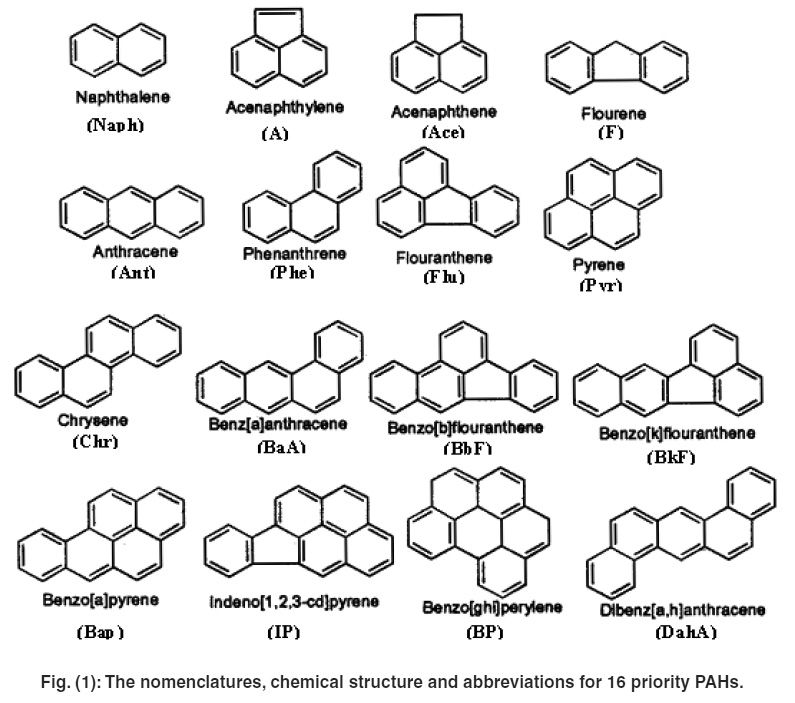 |
Figure (1): The nomenclatures, chemical structure and abbreviations for 16 priority PAHs. Click kere to view figure |
Several reports have rerecorded the contamination level of a variety of pollutants in Temsah lake and its marine organisms, including dioxins (Tundo et al., 2004 and 2005) chlorinated hydrocarbons, polychlorinated biphenyl and PAHs (Ahmed et al., 2001 and Said and Agroudy, 2006). Temsah Lake is exposed to a variety of aliphatic and aromatic hydrocarbons that originate from shipping activities, ballasting water, maintenance and maritime works in the several clocks around (Tundo et al., 2005).
There is still a lack of information in the levels and distribution of PAHs in Temsah Lake water, sediment and fish. The purpose of the present work is to survey the major sources of PAHs and identify its levels in addition to the distribution of individual PAHs in order to establish an up to date PAHs environmental monitoring to be useful as a reference for future studies and conservation programs about contamination levels in Temsah Lake.
Table - 1: Sampling sites
| Sites | Water | Type of sample Sediment | Fish |
| 1 | W1 | S1 | F1 |
| 2 | W2 | Rock area | Not represented |
| 3 | W3 | S3 | F3 |
| 4 | W4 | S4 | Not represented |
| 5 | W5 | Rock area | Not represented |
| 6 | W6 | Rock area | Not represented |
| 7 | W7 | S7 | Not represented |
| 8 | W8 | S8 | Not represented |
| 9 | W9 | S9 | F9 |
| 10 | W10 | S10 | Not represented |
| 11 | W11 | S11 | F11 |
Material and Methods
Samples Locations
Eleven surface water, eight surface sediment and four fish samples were collected from different sites all over the Temsah Lake in August 2005 for this study. The names and geographic locations of these sites are represented in table (1) and Fig. (2).
Samples Collection
Surface water samples were collected using narrow neck borosilicate glass bottles with Teflon lined caps. The samples were acidified to pH2 using 10% HCl to preserve them against bacterial action during transportation and storage. Surface sediment (0-2cm) samples were collected using a Van Veen grab sampler. Sediments from individual stations were well mixed and stored at refrigerator in pre-cleaned jars until analysis (Readman et al., 2002). Fish samples were collected from different sites to represent various zones of territorial water, wrapped in clean aluminum foil and then they were frozen at -20oC until analysis.
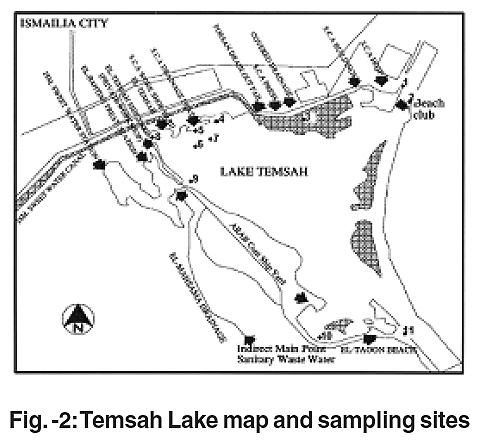 |
Figure - 2: Temsah Lake map and sampling sites Click kere to view figure |
Extraction of Oil
Water Samples
Oil was extracted from water samples using carbon tetrachloride (CCl4) according to the method described by Moustafaa, (2004). The TPH concentration in the extract was determined gravimetrically (El-Tokhi and Moustafa, 2001).
Sediment Samples
Sediment dry mass (dm) was determined from the weight loss after heat treatment (20h at 105oC) (Margesin et al., 2003). Extraction of dried sediment sample in a soxhlet extractor apparatus using a mixture of n-hexane and dichloromethane (1:1 v/v) was done (Viguri et al., 2002). The TPH concentration in the extract was determined gravimetrically (El-Tokhi and Moustafa, 2001).
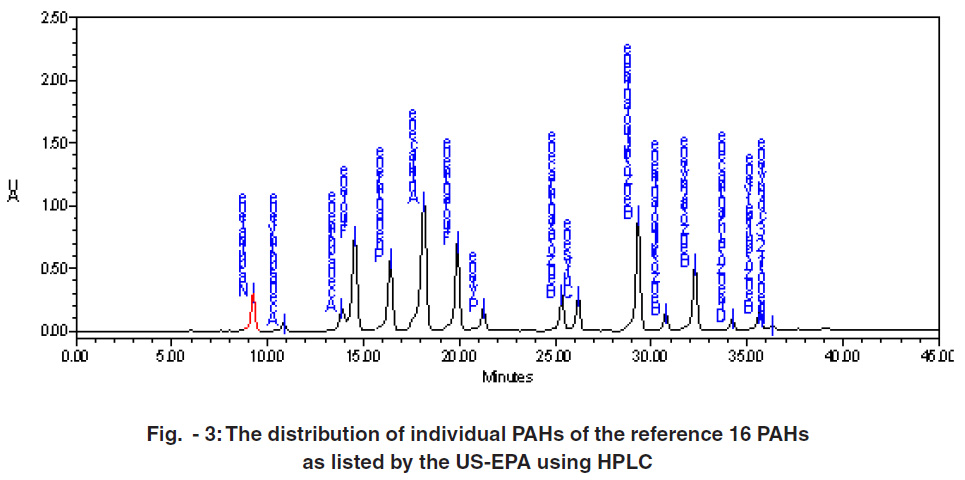 |
Figure - 3: The distribution of individual PAHs of the reference 16 PAHs as listed by the US-EPA using HPLC Click kere to view figure |
Fish Samples
Fish samples were thawed before gills, muscles and skins were cut down into small pieces, each sub-sample was ground in a pestle and mortar with 2 g anhydrous sodium sulphate. The cake was then extracted with 60 ml mixture hexane/ dichloromethane (1:1) v/v. The mixture was filtered and the tissue was extracted twice more. Organic solvent fractions were combined and filtered through filter paper with 2g anhydrous sodium sulphate. The extract was then reduced to about 2 ml using a rotary evaporator.
Saponification; The concentrated fish extract (2 ml) was transferred to a round-bottom flask and 100 ml aqueous methanolic KOH was added. The mixture was refluxed for 3h.
Saponified material was transferred to a separating funnel. The round-bottom flask was quantitatively rinsed with 150-200 ml mixture of methanol-distilled water 4:1 v/v. The mixture was transferred to a separating funnel and 100ml of n-hexane was added and then funnel shaken for 3min. Layers were allowed to separate and then organic layer was collected in another beaker. The extraction of the aqueous layer was repeated with 50ml n-hexane and layers were allowed to separate and the aqueous layer discarded. Organic layers were collected and carefully evaporated in a rotary evaporator to about 1ml. (Meddleditch et al., 1977).
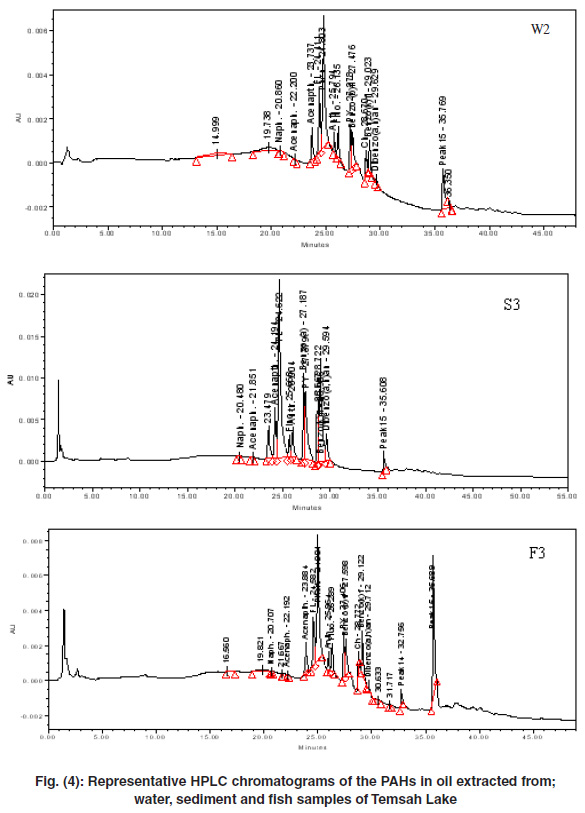 |
Figure (4): Representative HPLC chromatograms of the PAHs in oil extracted from; water, sediment and fish samples of Temsah Lake Click kere to view figure |
High Performance Liquid Chromatographic Analysis
PAHs identification and quantification in the extracted oil of all samples was perforfmed using HPLC model Waters 600E equipped with auto sampler Waters 717 plus and dual wavelength absorbance detector Waters 2487 set at 254 nm. PAHs standards were obtained from Supelco. The condition of operation is as follows (Lai et al., 1996): Column: Supelcosil LC-PAH, 15 cm x 4.6mm ID, 5 µm particles size. Mobile phase: Acetonitrile/water HPLC grades, gradient from 50:50 to 100% acetonitrile. Flow rate: Gradient program; 0-2min, 0.2 ml/min then 2-45min, 1.0 ml/min.
Results and Discussion
The distribution and separation of individual PAHs of the reference 16 PAHs listed by the US EPA (Ke et al., 2002) using HPLC is shown in fig. (3).
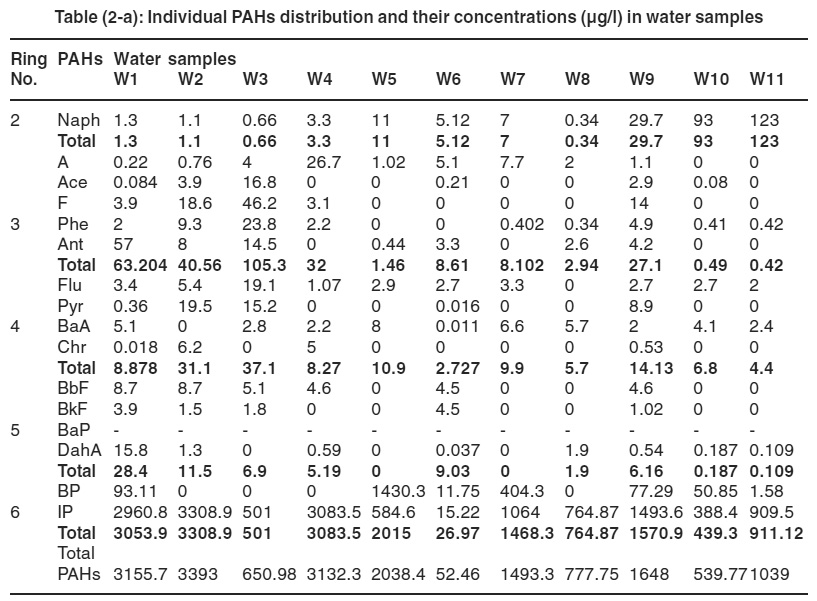 |
Table (2-a): Individual PAHs distribution and their concentrations (μg/l) in water samples Click kere to view table |
Qualitative and quantitative estimation of the individual PAHs for the extracted oils from water, sediment and fish samples of Temsah Lake were done and representative model samples are shown in fig. (4).
Careful examination of the HPLC chromatograms show that, each sample has its own distribution pattern and all have most of the target compounds. The brief identification of the present PAHs as shown in tables (2, 3 and 4) reveal the presence of both LPAHs and HPAHs. Generally in all the water, sediment and fish samples there is a higher concentration of HPAHs compared to that of LPAHs. It is well known that the most important anthropogenic sources of PAHs are petrogenic and Pyrolytic, the latter type is usually prevalent in aquatic environments (Zakaria et al., 2002 and Stout et al., 2004).
 |
Table (2-b): PAHs parameters used to distinguish petrogenic from pyrogenic origin of PAHs Click kere to view table |
Some molecular indexes play a major role in establishing the origin of PAHs, in particular; the ratios between low and high molecular weight PAHs (Magi et al., 2002), or the ratio of some isomers; e.g. phenanthrene/anthracene and flourantherene/ Pyrene. They were chosen according to their thermodynamic stability (Tolosa et al., 2004), among the three-ring isomers; Phen. is thermodynamically more stable and its prevalence over Ant. supports petrogenesis. Indeed, petroleum usually exhibits a quite high Phen/Ant ratio, among the four-ring isomers; Flu. is thermodynamically less stable than Pyr. Flu/Pyr>1; indicates Pyrolytic and Flu/Pyr<1 indicates petrogenic genesis of PAHs. Baumarda,b et al., (1998) suggested that only the evaluation of both the ratios Phen/Ant and Flu/Pyr could prevent a misleading estimate of PAH sources. According to De Luca et al., (2005); petrogenic contamination is characterized by the predominance of the LPAHs (with three and four fused rings), while the HPAHs prevail in Pyrolytic PAHs. But ratio of LPAHs : HPAHs is usually used as indices of weathering (Bernard et al., 1996; Zakaria et al., 2001; Moustafab, 2004 and Hwang and Foster, 2006).
Water Samples
Qualitative and quantitative distribution of PAHs detected in water samples have followed no particular pattern, but were rather irregular. Their levels are high, ranging between 52.46-3393µg/l which are alarmingly high. Generally the samples are characterized by high concentration of the six membered ring; Indeno(1,2,3-cd)Pyrene, ranging between 501-3308.9µg/l except for sample W6 which is characterized by low concentration of IP of 15.22µg/l. It can be observed also that water samples are generally characterized by low ratios of Σ 6LPAHs : Σ 10HPAHs, as shown in table (2-b) which might be presumably because of the relatively higher volatility of these LPAHs compounds which restrict their residence in water, especially in warm weather (Ahmed et al., 1998 and Zakaria et al., 2001).
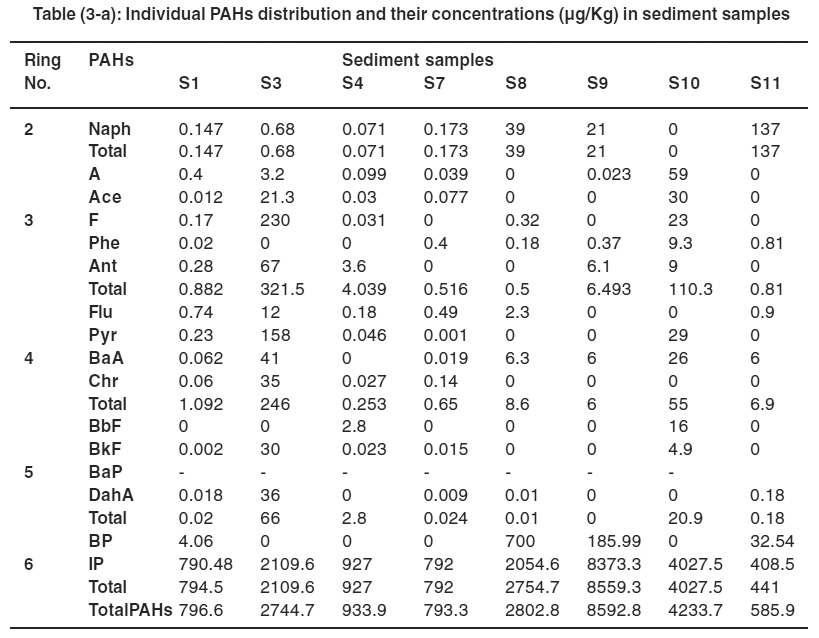 |
Table (3-a): Individual PAHs distribution and their concentrations (μg/Kg) in sediment samples Click kere to view table |
This may also indicates high pyrogenic genesis of PAHs in Temsah Lake (Magi et al., 2002). Regarding to Phe/Ant ratio, samples W4, W7, W10 and W11 have values of infinity due to the absence of anthracene indicating purely petrogenic origin, In contrary; regarding to Flu/Pyr ratio of these four samples have the value of infinity which is due to the absence of Pyrene indicating purely petrogenic origin. This misleading in results may be due to weathering or the presence of both pyrogenic and petrogenic genesis of PAHs due to the different outlets of effluents discharged into the lake and the accessibility of Temsah Lake to different sources of potential contaminates and polluters. For samples W5 and W6 Phe/Ant ratio is zero due to the absence of Phe indicating purely pyrogenic origin, which is confirmed by the ratio of Flu/Pyr; which are infinity and 169 for W5 and W6, respectively. But, for sample W1; Phe/Ant value is <1 and Flu/Pyr >1, indicating pyrogenic genesis of PAHs. For samples W2 and W9; Phe/Ant value > 1 and Flu/Pyr < 1, indicating petrogenic genesis of PAHs. For sample W3; Phe/Ant and Flu/Pyr values are close to one, indicating a mixture of petrogenic and pyrogenic origin of PAHs. On the other hand, sample W8 has a zero value for Flu/Pyr ratio and Phe/Ant value is close to zero, indicating also a mixture of petrogenic and pyrogenic genesis of PAHs. In conclusion, there are some discrepancies between the results obtained using the different parameters. The petrogenic genesis in Temsah Lake may result from the presence of some potential polluters such as dry docks and ships and tankers passing through the Suez Canal, also they may be due to the presence of dockyards and ship-maintenance works for example S.C.A. workshop yard Lake Temsah, El-Temsah Ship yard (private workshop) and Arab Cont. ship yard (Temsah Lake map, fig., 2). The high pyrogenic genesis is probably the result of the massive discharge of industrial effluents into the lake (Tundo et al., 2004) and the surrounding Forsain drain out fall, covered drainage and El-Mahmasa drainage, which is an indirect main point for sanitary waste water (Temsah Lake map, fig.,2) (Tundo et al., 2004).
 |
Table (3-b): PAHs parameters used to distinguish petrogenic from pyrogenic origin of PAHs Click kere to view table |
Sediment Samples
Qualitative and quantitative distribution of PAHs detected in sediment samples have followed no particular pattern, but were rather irregular and their level are alarmingly high, ranging between 585.9-8592.8µg/kg, the presence of such high concentrations are considered to be toxic (Moustafab, 2004).
 |
Table (4-a): Individual PAHs distribution and their concentrations (μg/Kg) in Fish samples Click kere to view table |
PAHs are contaminants of marine coastal sediments because of their hydrophobic character (water solubility between 10-10 and 10-13 mol/l) they are easily sorbed onto suspended particulate (Raoux et al., 1999 and De Luca et al., 2005). In this form they are more persistent to biodegradation in comparison to dissolved PAHs (Chiou et al., 1998; Soclo et al., 2000 and De Luca et al., 2005). This explains why their concentration in sediments could be higher than that in the overlaying water column as in samples of S3, S8 and S9. Generally all the collected sediment samples are characterized by high concentrations of the six membered ring; Indeno(1,2,3-cd)Pyrene, ranging between 408.5-8373.3µg/kg. Sample S3 has high concentration of Fluorene and Pyrene; 230µg/kg and 158µg/kg, respectively. Samples S8 and S9 are characterized by high concentration of Benzo[ghi]perylene; 700µg/ kg and 185.99µg/kg, respectively. Generally all the collected sediment samples are characterized by low concentration of diaromatic ring compound; naphthalene except for sample Σ 11 of concentration 137µg/L and also they are characterized by low concentration of triaromatic ring compounds except for samples S3 and S10 of concentration; 321.5µg/kg and 130.3µg/kg, respectively. Weathering causes considerable changes in the chemical and physical properties of spilled oils as well as the PAHs (Zakaria et al., 2001). Due to evaporation, dissolution and biodegradation, low molecular weights PAHs are thought to be selectively disappeared. As weathering increases the summation of the 6LPAHs decreased which makes the Σ6LPAHs : Σ10HPAHs parameter not useful to detect the origin. On the other hand it could be useful in the comparison of the weathering effects on the samples (Zakaria et al., 2001). Data obtained show low ratios of Σ6LPAHs : Σ10HPAHs as listed in table (3-b) indicating that all the sediment samples were subjected to weathering in different degrees. Based on this; weathering could explain the decrease of Naph concentration in all samples and also sample S11 could be considered as the least affected by weathering. Considering the different origins of PAHs; these sources induce a different chemical behavior in marine sediments; e.g. the interaction with sediments and resistance to biodegradation is higher for Pyrolytic than for petrogenic PAHs (Gustafsson et al., 1997 and Wang et al., 2006), this could explain the high concentration of the HPAHs in all the collected sediment samples compared to that of the LPAHs. Regarding to Phe/ Ant ratio; samples S1 and S4 are < 1 with Flu/Pyr >1, indicating pyrogenic genesis of PAHs. But for samples; S3 and S9 Phe/Ant ratio is < 1 with Flu/ Pyr < 1, indicating a mixture of petrogenic and pyrogenic genesis of PAHs. For samples S7, S8 and S11; regarding to Phe/Ant ratio they have values of infinity due to the absence of anthracene indicating purely petrogenic origin, but in contrary; regarding to Flu/Pyr ratio of these samples S8 and S11 they also have the value of infinity which is due to the absence of Pyrene and for sample S7 Flu/Pyr ratio is 490; indicating purely petrogenic origin. This misleading in results may be due to weathering or the presence of both pyrogenic and petrogenic genesis of PAHs due to the different outlets of effluents discharged into the lake.
 |
Table (4-b): PAHs parameters used to distinguish petrogenic from pyrogenic origin of PAHs Click kere to view table |
Fish Samples
Qualitative and quantitative distribution of PAHs detected in fish samples have also followed no particular pattern, but were rather irregular. Various reports have pointed to such irregularity in PAHs detected in fish (Cocchieri et al., 1990; Al-Yakoob et al., 1993 and Ahmed et al., 1998). Varanasi et al., (1989) explained these irregularities in view of PAHs uptake by fish as well as levels and routes of exposure, environmental factors, salinity and differences in species, age and sex. Moreover, laboratory studies have been shown that the extraction and analytical methods used can overestimate or underestimate the concentrations in fish samples (May et al., 1982 and Ahmed et al., 1998). Generally, the concentration of PAHs in fish samples involved in this study is high, which could explain the decline of fish population in Temsah Lake. Similar observations were listed by Ahmed et al., 2001 and reported that high contamination level is the main cause behind the decline in the lake biodiversity and fish quality harvested from the lake. All of the collected fish samples are characterized by the presence of high concentration of the six membered ring compound Indeno(1,2,3-cd)Pyrene; ranging between 1013.9µg/kg and 4122.2µg/kg. Samples F1 and F9 are characterized by the presence of high concentration of the six membered ring compound Benzo[ghi]perylene; 1224.2µg/kg and 600.0µg/kg, respectively, but it is not found in samples F3 and F11. Regarding to Phen/Ant ratio, samples F1 and F3 have value close to 1 indicating a mixture of petrogenic and pyrogenic origin of the PAHs. The Flu/Pyr<1 indicates that the petrogenic genesis of PAHs are higher than that of pyrogenic one. But for samples F9 and F11; Phen/ Ant ratio is zero due to the absence of Phen, indicating purely petrogenic origin this is confirmed by the Flu/Pyr ratio which is <1 this may be due to their proximity to a dockyard and a ship-maintenance works (Temsah Lake map, fig., 2) where oil and other contaminants spills are likely could be the reason for such high concentration of PAHs (Tundo et al., 2004).
It can be observed also that fish samples are generally characterized by low ratios of Σ6LPAHs : Σ10HPAHs, as shown in table (4-b) which is considered as a very serious alarm for the sever toxicity of these ten HPAHs. Several PAHs are known to be potential human carcinogen; these include benz[a]anthracene, chrysene, benzo[b] flouranthene, benzo[a]pyrene and benzo[ghi] perylene (Guillen et al., 2000 and Anyokora,2005). The health hazards posed by these compounds have been studied extensively by several authors (Perera et al., 1988 and Schoket et al., 1993). The presence of these compounds in the environmental samples (sediment, water and fish) has also been studied by numerous authors (Xu and Fang 1988 and Speer et al., 1990).
Conclusion
The qualitative and quantitative assessment of PAHs in water, sediments and fish samples of Temsah Lake indicated that they are highly affected by PAHs contamination which is problematic due to their propensity to initiate carcinogenic and or mutagenic effects in terrestrial as well as aquatic biota. These results contribute to better information of PAHs distribution, to a field validation, providing a technical basis to evaluate and pursue pollution abetments in Temsah Lake.
References
- Ahmed M.T., Moustafa G.A., Al Rasbi S.A., Askar A. “Capillary gas chromatography determination of aliphatic hydrocarbons in fish and water from Oman” J.Chemosphere, (1998) 36(6), 1391-1403.
- Ahmed M.T., Nagla L., El Shiekh E., Mosleh Y, Abdel Moniem I. “Residues of chlorinated hydrocarbons, polycyclic aromatic hydrocarbons and polychlorinated biphynel in some aquatic organisms in Lake Temsah around Ismailia” J.Aquatic Ecosystem Health and Management, (2001) 4, 165-173.
- Al-Yakoob S., Talat S. and Al-Hashash H. “Polycyclic aromatic hydrocarbons in Edible tissue of fish from the Gulf after 1991 oil spill” Marine Pollution Bulletin, (1993) 27, 297-301.
- Anyakora C., Ogbeche A., Palmer P., Coker H., Ukpo G. and Ogah C.,”GC/MS analysis of polynuclear aromatic hydrocarbons in sediment samples from the Niger Delta region” Chemosphere, (2005) 60(7), 990-997.
- Baumarda P., Budzinski H. and Garrigues P. “Polycyclic aromatic hydrocarbons in sediments and mussels of the western Mediterranean sea” Environmental Toxicology and Chemistry (1998) 17, 765-776.
- Baumardb P., Budzinski H., Michon Q., Garrigues P., Burgeot T. and Bellocq J. “Origin and bioavailability of PAHs in the Mediterranean sea from mussel and sediment records” Estuarine Coastal and shelf Science (1998) 47, 77-90.
- Bernard D., Pascalin H. and Jeremie J. “Distribution and Origin of Hydrocarbons in Sediments from Lagoons with Fringing Mangrove Communities” Marine Pollution Bulletin, (1996) 32(10), 734 739.
- Chiou C.T., McGroddy S.E. and Kile D.E. “Partition characteristics of polycyclic aromatic hydrocarbons on soils and sediments” Environmental Science and Technology, 32, 264-269 (1998).
- Cocchieri R.A., Arense A. and Minicucci A.M. “Polycyclic aromatic hydrocarbons in marine organisms from Italian Central Mediterranean coasts” Marine Pollution Bulletin (1990) 28(2), 89-95.
- De Luca G., Furesi A., Micera G., Panzanelli A., Piu P.C., Pilo M.I., Spano N., Sanna G. “Natural, distribution and origin of polycyclic aromatic hydrocarbons (PAHs) in the sediments of Olbia harbor (Northern Sardinia, Italy)” Marine Pollution Bulletin, (2005) 50(11), 223-1232.
- El-Tokhi M.M. and Moustafa Y.M. “Heavy metals and petroleum hydrocarbons contamination of bottom sediment of El-Sukhna area, Gulf of Suez, Egypt”. Petroleum Science and Technology, (2001) 19(5/6), 481-494.
- Guillen M.D., Sopelana P., Partearroyo M.A. “Determination of polycyclic aromatic hydrocarbons in commercial liquid flavorings of different compositions by gas chromatography-mass spectrometry” J. Agriculture. Food Chemistry, (2000) 48, 126-131.
- Gustafsson O., Haghseta F., Chan C., Macfarlane J. and Gschwend P.M. “Quantification of the dilute sedimentary soot-phase: Implication for PAH speciation and bioavailability” Environmental Science and Technology (1997) 31, 203-209.
- Hatch A.C. and Burton GA.”Photo-induced toxicity of PAHs to Hyalella Azteca and Chironomus Tentans: effect of mixtures and behavior” Environmental Pollution, (1999) 106, 157-167.
- Hwang, H.M. and Foster, G.D. “Characterization of polycyclic aromatic hydrocarbons in urban storm water runoff flowing into the tidal Anacostia River, Washington, DC,USA” Environmental Pollution, (2006) 140, 416-426.
- Ke L., Teresa W.Y., Wong Y.S. and Nora F.Y. “Fate of polycyclic aromatic hydrocarbon (PAH) contamination in a mangrove swamp in Hong Kong following an oil spill.” Marine Pollution Bulletin, (2002) 45, 339-347.
- Lai B. and Khanna S. “Degradation of crude oil by Acinetobacter calcoaceticus and Alcaligenes odorans.” J. Applied Bacteriology, (1996) 81, 355-362.
- Liu K., Han W.,Pan W.P. & Riley J.T., “Polycyclic aromatic hydrocarbon (PAH) emissions from a coal fired pilot FBC system”, J. Hazardous Materials, (2001) 84, 175-188.
- Magi E., Bianco R., Ianni C.and Di Carro M. “Distribution of polycyclic aromatic hydrocarbons in the sediments of the Adriatic sea” Environmental Pollution, (2002) 119, 91-98.
- Maskaui K., Zhou J.L., Hong H.S. and Zhang Z.L. “Contamination by polycyclic aromatic hydrocarbons in the Jiulong River estuary and western Xiamen Sea, China.” Environmental Pollution, (2002) 118, 109-122.
- Margesin, R., Labbé, D., Schimer, F., Greer, C. W. and Whyte, L. G. “Characterization of hydrocarbon degrading microbial population in contaminated and pristine alpine soil” Applied Environmental Microbiology, (2003) 69(6), 3085-3092.
- May W.E., Chesler S.N., Hertz H.S. and Wise S.A. “Analytical standards and methods for the determination of polynuclear aromatic hydrocarbons in environmental samples” Int.J. Environmental Analytical Chemistry, (1982) 2, 259-75.
- Middleditch B., Basile B. and Chang E, J.” Environmental effects of offshore oil production: Alkanes in the region of the Buccaneer oilfield” Chromatography, (1977) 142, 777-785.
- Moustafaa Y.M. “Contamination by polycyclic aromatic hydrocarbons in some Egyptian Mediterranean Coasts” Biosciences, Biotech. Research Asia, (2004) 2(1), 15-24.
- Moustafab Y.M.,”Environmental assessment of petroleum contamination of Gamasa-Damiette beaches” Oriental Journal of chemistry, (2004) 20(2), 219-226.
- Perera F.P., Hemminki K., Young T.L. “Detection of polycyclic aromatic-DNA adduct in white blood cell of foundry workers” Cancer Research, (1988) 48, 2288-2291.
- Raoux, J.M.Bayona, J.C. Miquel, J.L. Teyssie, S.W. Fowler and J. Albaigés “Particulate fluxes of aliphatic and aromatic hydrocarbons in near-shore waters to the North-western Mediterranean Sea, and the effect of continental runoff, Estuarine, Coastal Shelf Science, (1999) 48, 605-616.
- Readman J.W., Fillmann G., Tolosa I. , Bartocci J. , Villeneuve I.P. , Catinni C. and Mee L.D. “Petroleum and PAH contamination of the Black Sea.” Marine Pollution Bulletin, (2002) 44, 48-62.
- Said T., and Agroudy N. “Assessment of PAHs in water and fish tissues from Great Bitter and El Temsah Lakes, Suez Canal, as chemical markers of pollution sources” Chemistry and Ecology, (2006) 22(15),159-173.
- Samanta S., Singh O.V., and Jain R.K “Polycyclic aromatic hydrocarbons environmental pollution and bioremediation” Trends in Biotechnology, (2002) 20, 243-248.
- Schoket B., Doty W.A. and Vincze I. “Increased sensitivity for determination of polycyclic hydrocarbon-DNA adducts in human DNA samples by dissociation-enhanced lanthanide flouroimmunoassay (DELFIA)” Cancer Epidemol. Biomarker prevention, (1993) 2, 349-353.
- Soclo, H.H., Garrigues, P., Ewald, M. “Origin of polycyclic aromatic hydrocarbons (PAHs) in Coastal marine sediments: case studies in Cotonou (Benin) and Aquitaine (France) areas” Marine Pollution Bulletin, (2000) 40, 387-396.
- Speer K., Steeg E., Horsetmann P., Kuhn Th., Montang A. “Determination and distribution of PAH in native vegetable oils, smoked fish products, mussels and Oysters, and bream from the river Elbe” J. High Resolution Chromatography, (1990) 13, 104-111.
- Stout S.A., Uhler A.D. and Emsbo-Mattingly S.D. “Comparative evaluation of background anthropogenic hydrocarbons in surficial sediments from nine urban waterway” Environmental Science and Technology, (2004) 38, 2987-2994.
- Tolosa I., Mora S., Sheikholeslami M., Villeneuve J., Bartocci J. and Cattini C. “Aliphatic and aromatic hydrocarbons in coastal Caspain Sea sediments” Marine Pollution Bulletin, (2004) 48(1-2), 44-60.
- Tundo P, Raccanelli S,Reda L, Ahmed M.T. “Distribution of polychlorinated dibenzo-p-dioxins,polychlorinated dibenzofurans, dioxin-like polychlorinated biphenyl and polycyclic aromatic hydrocarbons in the sediment of Temsah Lake. Suez Canal, Egypt” Chemistry and Ecology, (2004) 20, 257-265.
- Tundo P, Reda L.A., Mosleh Y, Ahmed M.T. “Residues of PCDD, PCDF, and PCBs in some marine organisms in Lake Temsah, Ismailia, Egypt” J. Tox. & Env. Chem., (2005) 87(1), 21-30.
- Varanasi U., Stein J.E. and Nishimoto M. “Biotransformation and deposition of polycyclic aromatic hydrocarbons (PAHs) in Fish. In metabolism of polycyclic aromatic hydrocarbons in the Aquatic environment” (U.Varanasi,ed.), 93-149 (1989). Boca Raton, FL: CRC press.
- Viguri J., Verde J. and Irabien A. “Environmental assessment of polycyclic aromatic hydrocarbons (PAHs) in surface sediments of the Sanader Bay, Northern Spain.” Chemosphere, (2002) 48, 157-165.
- Wang, X.C., Sun,S., Ma, H.Q., Liu, Y. “Sources and distribution of aliphatic &polyaromatic hydrocarbons in sediments of Jiaozhou Bay, Qingdao, China” Marine Pollution Bulletin, (2006) 52,129-138.
- Xu B.X.,Fang Y.Z. “Determination of polynuclear aromatic hydrocarbons in water by floatation enrichment and HPLC” Talanta, (1988) 35 (11), 891-894.
- Zakaria M.P., Takada H., Tsutsumi S., Ohno K., Yamada J., Kouno E. and Kumata H. “Distribution of polycyclic aromatic hydrocarbons (PAHs) in rivers and estuaries in Malaysia: A wide spread input of petrogenic PAHs” Environmental Science and Technology, (2002) 36, 1907-1918.
- Zakaria, M.P., Okuda T. and Takada H. “Polycyclic aromatic hydrocarbons (PAHs) and Hopanes in stranded tar-balls on the coastal of peninsular Malaysia. Application of biomarkers for identifying sources of oil pollution” Marine Pollution Bulletin, (2001) 142(12), 1357-1366.






